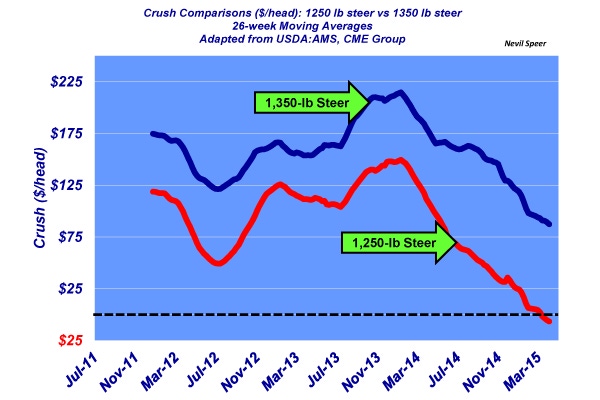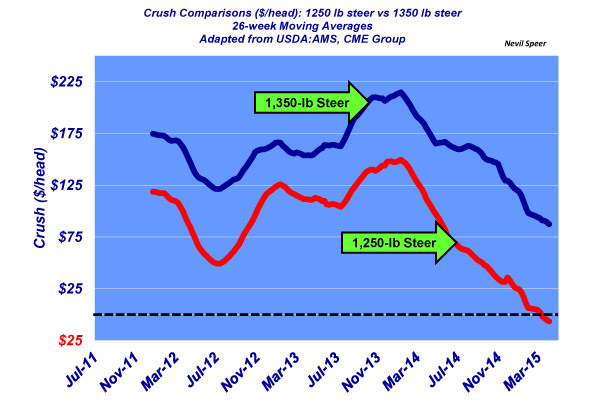How will heavier finish weights influence the feeder cattle market?
April 20, 2015

Last week’s Industry At A Glance highlighted the growing importance of heavier slaughter weights with respect to revenue generation, and noted its significant influence with respect to valuation of feeder cattle. That is that the revenue difference between a steer marketed at 1,350 pounds or more versus the traditional 1,250-pound target is substantial. And feeder cattle are priced accordingly: 1,250-pound prospects must be valued behind cattle that can achieve 1,350 pounds or more.
Meanwhile, there’s a secondary influence of heavier weights on the business in that it changes many long-held assumptions about breakevens and risk management at the time of purchase. The accompanying illustration draws attention to that reality.
Insight into the weekly buy can be facilitated through analysis of the crush – it provides some perspective into the trends of gross margin at the feedyard level. There are several crush variations utilized in the industry. However, most commonly, it’s derived through revenue of a 1,250-pound steer using the appropriate out-front live cattle futures contract.Meanwhile, that crush margin also invokes costs associated with the purchase of feeder cattle and need for corn. The revenue (six live cattle futures contracts) less costs (three feeder cattle and two corn futures contracts) comprises the crush margin. If one were to look only at 1,250-pound steers, the crush margin would have placed a cattle feeder in negative territory in recent months before any other costs were incurred. However, calculating a 13-6-5 crush (live cattle, feeder cattle and corn futures, respectively) based on a 1,350-pound steer depicts the gross margin in a very different light.
If one were to look only at 1,250-pound steers, the crush margin would have placed a cattle feeder in negative territory in recent months before any other costs were incurred. However, calculating a 13-6-5 crush (live cattle, feeder cattle and corn futures, respectively) based on a 1,350-pound steer depicts the gross margin in a very different light.
The crush contracts are adjusted for heavier out-weights and a longer feeding period (thus needing more corn per head). While the two margin lines largely track together, the different curves reveal the enhanced hedging opportunity and improved breakeven opportunities based on bigger weights in recent years.
How do you perceive the influence of bigger weights on the feeder cattle market? How do you think that influence plays out for cattle feeders when buying replacements? What might the trend of this difference look like in the year(s) to come?
Leave your thoughts in the comments section below.
Other articles you might enjoy:
When should you call the vet on a difficult calving?
60+ stunning photos that showcase ranch work ethics
Try one of these 9 ranch management concepts to improve your ranch
How to treat lump jaw disease in cattle
About the Author(s)
You May Also Like





